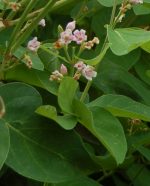
Also called fly-trap dogbane and bitterroot, this lanky herbaceous perennial is a member of the dogbane family, Apocynaceae, that also includes milkweed, bluestar, periwinkle, and oleander. It is native to North America from Massachusetts and Saskatchewan, south to Florida and Arizona where it grows in prairies, meadows, open woods, woodland edges, thickets, and along roadsides. The plants grow up to 4′ tall from a rhizomatous root system and have widely branching stems that are light green to red and contain milky sap when broken. The spreading or drooping dark green leaves are .4 to 5 inches long and oval with pointed tips. In autumn the foliage turns yellow, orange, or rose. During the summer terminal cymes 1-4″ wide appear and consist of slightly nodding flowers that are bell-shaped and fragrant. Each flower is 1/4″ wide and has 5 recurved petals that are white striped with pink. The fruit is a follicle 1.6 to 6″ long and contains numerous seeds with tufts of silky hair that facilitate wind dispersal. Spreading dogbane is a good choice for a meadow garden, wildlife planting, and erosion control. Plants are poisonous to humans, livestock, dogs, cats and other mammals but the flowers are an important food source of nectar for bees, wasps, flies, and butterflies. The genus name Apocynum, comes from the Greed words apo meaning asunder and kyon meaning dog referring to the belief that the plant was poisonous to dogs. The specific epithet, androsaemifolium, comes from the Greek words aner, andros meaning man and haima meaning blood, and the Latin word folium meaning leaf, and refers to the sap of the leaves.
Type: Herbaceous perennial
Bloom: Terminal clusters of white and pink, slightly nodding, bell-shaped flowers during the summer
Size: 1.5-34 H x 4′ W
Light: Sun to part sun
Soil: Lean, medium moist to dry, well-drained
Hardiness: Zones 4-8
Care: Low maintenance
Pests and Diseases: None of significance
Propagation: Division, seed
Companion Plants: Periwinkle, weeping forsythia, liriope, Miscanthus ‘Morning Light’
Photo Credit: Wikipedia